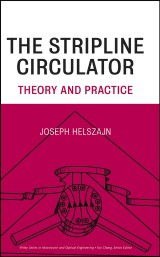Details

The Stripline Circulator
Theory and PracticeWiley Series in Microwave and Optical Engineering, Band 206 1. Aufl.
|
175,99 € |
|
| Verlag: | Wiley |
| Format: | |
| Veröffentl.: | 16.05.2008 |
| ISBN/EAN: | 9780470264140 |
| Sprache: | englisch |
| Anzahl Seiten: | 608 |
DRM-geschütztes eBook, Sie benötigen z.B. Adobe Digital Editions und eine Adobe ID zum Lesen.
Beschreibungen
<b>Stripline circulator theory and applications from the world's foremost authority</b> <p>The stripline junction circulator is a unique three-port non-reciprocal microwave junction used to connect a single antenna to both a transmitter and a receiver. Its operation relies on the interaction between an electron spin in a suitably magnetized insulator with an alternating radio frequency magnetic field. In its simplest form, it consists of a microwave planar gyromagnetic resonator symmetrically coupled by three transmission lines.</p> <p>This book explores the magnetic interaction involved in the stripline circulator's operation, the nature of the microwave resonator shape, and the network problem that arises in coupling the microwave resonator to the microwave circuit. The stripline circulator is an important device met across a wide range of industries, including wireless, military, radar, and satellite communications. The book's design tables are a unique feature, offering valuable design support.</p> <p>Written by an international authority on non-reciprocal microwave circuits and devices, the book is organized into logical blocks of chapters that focus on specific effects and circuit aspects of the stripline circulator. Among the highlights of coverage are:</p> <ul> <li> <p>Spatial shape demagnetizing factors of magnetic insulators</p> </li> <li> <p>Standing wave solutions of wye gyromagnetic planar resonators</p> </li> <li> <p>Lumped element circulators</p> </li> <li> <p>Negative permeability tracking and semi-tracking circulators</p> </li> <li> <p>Four-port single-junction circulators</p> </li> <li> <p>Fabrication of very weakly and weakly magnetized microstrip circulators</p> </li> </ul> <p>The final chapter explores important and continuing discrepancies between theoretical models and actual practice. For designers building circulators, isolators, and phase shifters; researchers working on the limitation of ferrite devices; and graduate students intending to work in the field, Dr. Helszajn's insights and perspectives are invaluable.</p>
Preface. <p>1. Architecture of Symmetrical Stripline Junction Circulators.</p> <p>2. Tensor Permeability in a Magnetic Insulator.</p> <p>3. Spatial Shape Demagnetizing Factors of Disk, Equilateral Triangle, and Irregular Hexagonal Magnetic Insulators.</p> <p>4. Scattering Matrix of m-Port Junction.</p> <p>5. Eigenvalue Adjustment of Three-Port Circulator.</p> <p>6. Impedance Matrix of Junction Circulator.</p> <p>7. The One-Port Topology of the Degree-1 and Degree-2 Terminated Circulator.</p> <p>8. Cutoff Space of Cloverleaf Resonators with Magnetic Walls.</p> <p>9. Standing Wave Solution of Wye Gyromagnetic Planar Resonator.</p> <p>10. Planar Resonators with Triplets of Radial and Circumferential Magnetic Walls.</p> <p>11. Unloaded Quality Factors of Junction Circulators.</p> <p>12. The Lumped Element Circulator.</p> <p>13. The Stripline Circulator Using a Gyromagnetic Planar Disk Resonator.</p> <p>14. Green's Function Description of Junction Circulator.</p> <p>15. Finite Element Formulation of Junction Circulator.</p> <p>16. Circulators Using Triangular and Irregular Hexagonal Planar Resonators.</p> <p>17. Operation of the Tracking and Semitracking Stripline Circulators.</p> <p>18. Complex Gyrator Circuit of Negative Permeability Tracking and Semitracking Circulators.</p> <p>19. Synthesis of Wideband Planar Circulators Using Narrow Coupling Angles.</p> <p>20. Complex Gyrator Circuit of Three-Port Circulators Using Gyromagnetic Resonators with Sixfold Symmetry.</p> <p>21. Open-Circuit Parameters of Circulators Using Side-Coupled Wye Resonators: An Impedance Pole Approach.</p> <p>22. The Four-Port Single Junction Stripline Circulator.</p> <p>23. Frequency Responses of Quarter-Wave Coupled Reciprocal Stripline Junctions.</p> <p>24. Scattering Matrices of Junction Circulators with Chebyshev characteristics.</p> <p>25. Synthesis of Stepped Impedance transducers.</p> <p>26. Fabrication of UHF Circulators Using Irregular Hexagonal Gyromagnetic Resonators.</p> <p>27. Fabrication of Very Weakly and Weakly Magnetized Microstrip circulators.</p> <p>28. The Stripline Circulator: Theory and Practice.</p> <p>Bibliography.</p> <p>Index.</p>
<p><b>Joseph HELSZAJN</b>, PhD, DSc, is a Chartered Engineer and a Fellow of the Institution of Electrical Engineers, the Institute of Electrical and Electronic Engineers, the City and Guilds Institute, the Royal Society of Edinburgh, and the Royal Academy of Engineering. He is the recipient of the 1995 Institution of Electrical Engineers J.J. Thomson Medal and was appointed an Officer of the Order of the British Empire in the 1997 Queen's Birthday Honours List. Dr. Helszajn is the recipient of the honorary degree of Doctor of Engineering from Napier University (2004) and the honorary degree of Doctor of the University from Heriot-Watt University (2007), both located in the United Kingdom.</p>
<p><b>Stripline circulator theory and applications from the world's foremost authority</b></p> <p>The stripline junction circulator is a unique three-port non-reciprocal microwave junction used to connect a single antenna to both a transmitter and a receiver. Its operation relies on the interaction between an electron spin in a suitably magnetized insulator with an alternating radio frequency magnetic field. In its simplest form, it consists of a microwave planar gyromagnetic resonator symmetrically coupled by three transmission lines.</p> <p>This book explores the magnetic interaction involved in the stripline circulator's operation, the nature of the microwave resonator shape, and the network problem that arises in coupling the microwave resonator to the microwave circuit. The stripline circulator is an important device met across a wide range of industries, including wireless, military, radar, and satellite communications. The book's design tables are a unique feature, offering valuable design support.</p> <p>Written by an international authority on non-reciprocal microwave circuits and devices, the book is organized into logical blocks of chapters that focus on specific effects and circuit aspects of the stripline circulator. Among the highlights of coverage are:</p> <ul> <li> <p>Spatial shape demagnetizing factors of magnetic insulators</p> </li> <li> <p>Standing wave solutions of wye gyromagnetic planar resonators</p> </li> <li> <p>Lumped element circulators</p> </li> <li> <p>Negative permeability tracking and semi-tracking circulators</p> </li> <li> <p>Four-port single-junction circulators</p> </li> <li> <p>Fabrication of very weakly and weakly magnetized microstrip circulators</p> </li> </ul> <p>The final chapter explores important and continuing discrepancies between theoretical models and actual practice. For designers building circulators, isolators, and phase shifters; researchers working on the limitation of ferrite devices; and graduate students intending to work in the field, Dr. Helszajn's insights and perspectives are invaluable.</p>


















